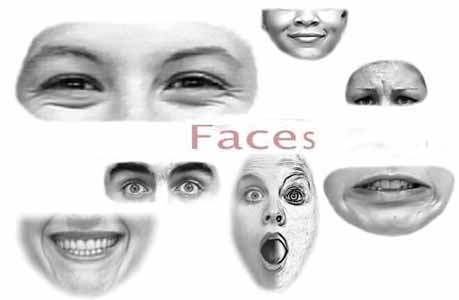

40 amazing facial reconstructions, from Stone Age shamans to King Tut Live Science - November 6, 2023
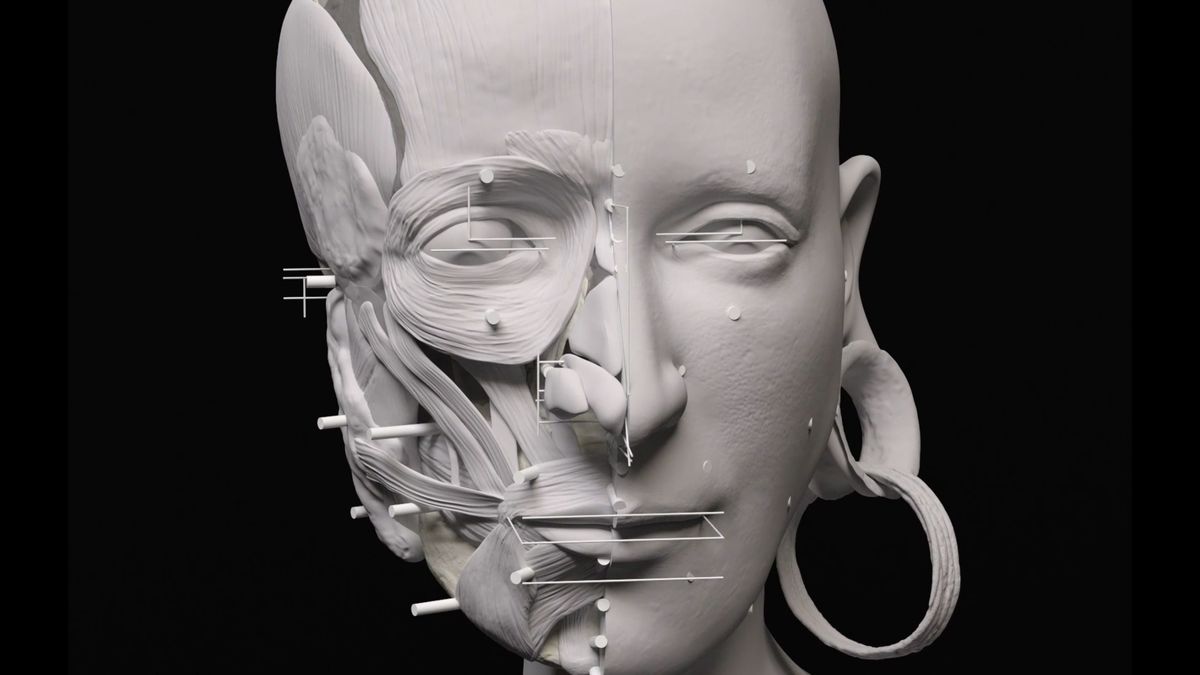
New scientific techniques are helping us reconstruct people from the past in uncanny detail.
Looking at a Human Face Triggers Activity in Our Brains Unlike Any Other Object Science Alert - March 22, 2021
When the participants in an experiment looked at human faces, neurons fired and synchronized between the amygdala and the hippocampus in a specific pattern that was different to the results from the other stimuli - which the team interprets as evidence of how the brain handles memory encoding for important social information, distinct from other non-social objects.
New Lie Detector Can Read Facial Muscles You Don't Even Know You're Using Science Alert - November 20, 2021
Humans are notoriously woeful lie detectors, even when staring liars straight in the face. A machine learning tool trained to detect tell-tale signs of lying has been found to do better than the average person, using little more than data from wearable sensors that pick up teensy flickers in facial muscles.
How emotions in facial expressions are understood Science Daily - June 2, 2018
New research reveals how well fearful facial expressions are perceived in peripheral vision. Although human vision has the highest resolution when we look directly at something, we see a much wider view of the visual world in our lower resolution peripheral vision. In fact, detecting signals of potential danger in our periphery - especially moving ones - is something our visual system is well adapted for.
Fifteen new genes identified that shape our face
Our DNA determines what we look like, including our facial features. That appeals to the popular imagination, as the potential applications are obvious. Doctors could use DNA for skull and facial reconstructive surgery, forensic examiners could sketch a perpetrator's face on the basis of DNA retrieved from a crime scene, and historians would be able to reconstruct facial features using DNA from days long gone.
But first, researchers need to figure out which genes in our DNA are responsible for specific characteristics of our face. We're basically looking for needles in a haystack. In the past, scientists selected specific features, including the distance between the eyes or the width of the mouth. They would then look for a connection between this feature and many genes. This has already led to the identification of a number of genes but, of course, the results are limited because only a small set of features are selected and tested.
Our faces reveal whether we're rich or poor Science Daily - July 5, 2017
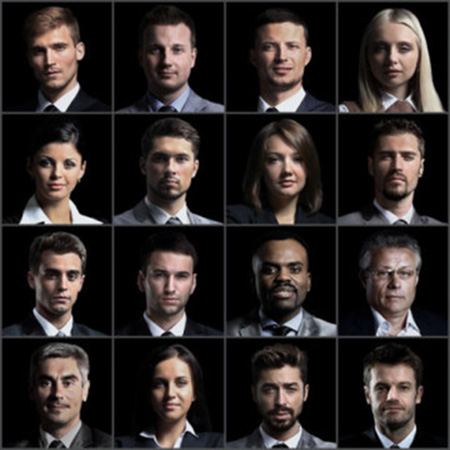
In a new twist on first impressions, the study found people can reliably tell if someone is richer or poorer than average just by looking at a "neutral" face, without any expression. People also use those impressions in biased ways, such as judging the rich faces more likely than the poor ones to be hired for a job. he researchers found the ability to read a person's social class only applies to their neutral face and not when people are smiling or expressing emotions. Emotions mask life-long habits of expression that become etched on a person's face even by their late teens or early adulthood, such as frequent happiness, which is stereotypically associated with being wealthy and satisfied.
Over time, your face comes to permanently reflect and reveal your experiences. Even when we think we're not expressing something, relics of those emotions are still there.
Face identification accuracy impaired by poor sleep Medical Express - October 6, 2016

However the study also found that poor sleepers were just as confident in their decisions, highlighting possible implications for security and policing. Participants were asked to decide whether two images, presented on a computer monitor at the same time, pictured the same person or two different people. The researchers set the task to differ from the face recognition tasks most of us encounter in our daily lives in two important ways: firstly, the people pictured in the images are unfamiliar. Secondly, the task did not involve memory, because the images appear on the screen at the same time. The authors noted that while most people would typically expect to perform well on these tasks, many are surprised at how many errors they make.
Study shows puberty changes facial recognition Science Daily - September 30, 2016
Faces are as unique as fingerprints and can reveal a great deal of information about our health, personalities, age, and feelings. Researchers recently discovered adolescents begin to view faces differently as they prepare for the transition to adulthood. The ability of adolescents to retune their face processing system, from showing a bias toward adult female faces as children, to preferring peer faces that match their own developmental stage in puberty, is part of the social metamorphosis that prepares them to take on adult social roles, say the authors of a new report.
Researchers reconstruct facial images locked in a viewer's mind PhysOrg - March 25, 2014
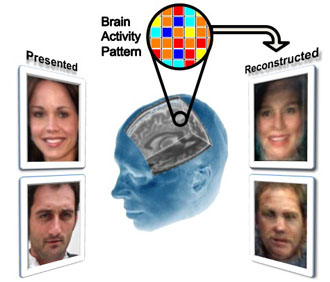
Using only data from an fMRI scan, researchers led by a Yale University undergraduate have accurately reconstructed images of human faces as viewed by other people. The increased level of sophistication of fMRI scans has already enabled scientists to use data from brain scans taken as individuals view scenes and predict whether a subject was, for instance, viewing a beach or city scene, an animal or a building.
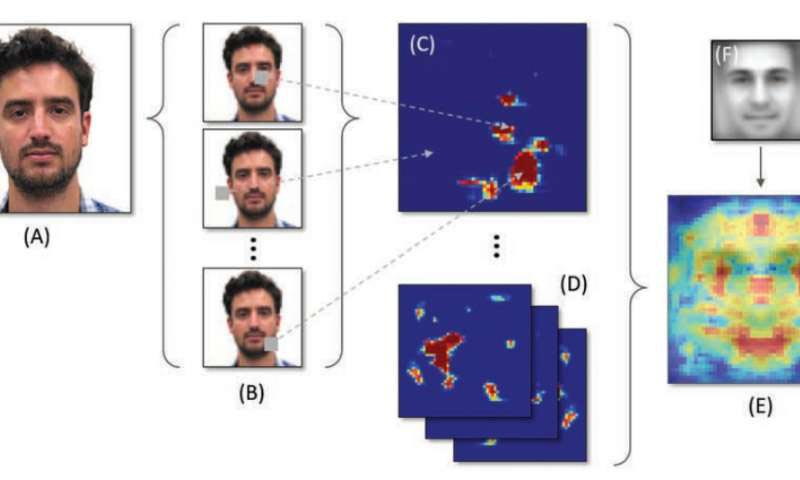
Do you look like your name? People can match names to faces of strangers with surprising accuracy Medical Express - February 27, 2017
If your name is Fred, do you look like a Fred? You might - and others might think so, too. New research has found that people appear to be better than chance at correctly matching people's names to their faces, and it may have something to do with cultural stereotypes we attach to names. Participants were shown a photograph and asked to select the given name that corresponded to the face from a list of four or five names. In every experiment, the participants were significantly better (25 to 40 percent accurate) at matching the name to the face than random chance (20 or 25 percent accurate depending on the experiment) even when ethnicity, age and other socioeconomic variables were controlled for.

Based on their brain programming, some people never forget faces - identify the faces of almost everybody they have ever encountered - even when the initial encounter was brief or long ago. They are often referred to as "Super Recognizers". Scientists believe that only about 1 percent of people fall into the super recognizer category. Most are unaware that they have this extraordinary skill. They just assume everybody remembers faces as well as they do.
Why do some people never forget a face? PhysOrg - December 1, 2011
"Face recognition is an important social skill, but not all of us are equally good at it," says Beijing Normal University cognitive psychologist Jia Liu. But what accounts for the difference? In daily life, we recognize faces both holistically and also analytically - that is, picking out individual parts, such as eyes or nose. But while the brain uses analytical processing for all kinds of objects - cars, houses, animals - holistic processing is thought to be especially critical to face recognition.
Some People Really 'Never Forget A Face:' Understanding Extraordinary Face Recognition Ability Science Daily - May 20, 2009
Psychologists have discovered that some people have an extraordinary ability to recognize faces, a group that they call "super-recognizers," who can easily recognize someone they met in passing, even many years later. The findings imply that face recognition may vary more than previously understood, and may be on a spectrum, with "super-recognizers" at the high end, and those with face blindness, who have extraordinary difficulty recognizing a face, at the low end.
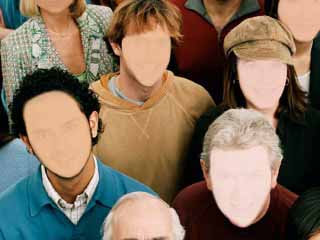
Test to diagnose 'face blindness' BBC - November 4, 2015
Scientists have come up with a questionnaire they say should help diagnose a condition called face blindness. Prosopagnosia, as doctors call it, affects around two in every 100 people in the UK and is the inability to recognize people by their faces alone. In its most extreme form, people cannot even recognize their family or friends. Milder forms, while still distressing, can be tricky to diagnose, which is why tests are needed. People with prosopagnosia often use non-facial cues to recognize others, such as their hairstyle, clothes, voice, or distinctive features.
Prosopagnosia (Greek: "prosopon" = "face", "agnosia" = "not knowing"), also called face blindness, is a disorder of face perception where the ability to recognize faces is impaired, while other aspects of visual processing (e.g., object discrimination) and intellectual functioning (e.g., decision making) remain intact. The term originally referred to a condition following acute brain damage (acquired prosopagnosia), but a congenital or developmental form of the disorder also exists, which may affect up to 2.5% of the population. The specific brain area usually associated with prosopagnosia is the fusiform gyrus, which activates specifically in response to faces. Thanks to this specialization, most people recognize faces much more effectively than they do similarly complex inanimate objects. For those with prosopagnosia, the ability to recognize faces depends on the less-sensitive object recognition system.
Though there have been several attempts at remediation, no therapies have demonstrated lasting real-world improvements across a group of prosopagnosics. Prosopagnosics often learn to use 'piecemeal' or 'feature by feature' recognition strategies. This may involve secondary clues such as clothing, gait, hair color, body shape, and voice.
Though there have been several attempts at remediation, no therapies have demonstrated lasting real-world improvements across a group of prosopagnosics. Prosopagnosics often learn to use 'piecemeal' or 'feature by feature' recognition strategies. This may involve secondary clues such as clothing, gait, hair color, body shape, and voice. Because the face seems to function as an important identifying feature in memory, it can also be difficult for people with this condition to keep track of information about people, and socialize normally with others. Prosopagnosia has also been associated with other disorders that are associated with nearby brain areas: left hemianopsia (loss of vision from left side of space, associated with damage to the right occipital lobe), achromatopsia (a deficit in color perception often associated with unilateral or bilateral lesions in the temporo-occipital junction) and topographical disorientation (a loss of environmental familiarity and difficulties in using landmarks, associated with lesions in the posterior part of the parahippocampal gyrus and anterior part of the lingual gyrus of the right hemisphere).
There are two types of prosopagnosia: acquired and congenital (developmental). Acquired prosopagnosia results from occipito-temporal lobe damage and is most often found in adults. This is further subdivided into apperceptive and associative prosopagnosia . In congenital prosopagnosia, the individual never adequately develops the ability to recognize faces. Read more ...
Because the face seems to function as an important identifying feature in memory, it can also be difficult for people with this condition to keep track of information about people, and socialize normally with others. Prosopagnosia has also been associated with other disorders that are associated with nearby brain areas: left hemianopsia (loss of vision from left side of space, associated with damage to the right occipital lobe), achromatopsia (a deficit in color perception often associated with unilateral or bilateral lesions in the temporo-occipital junction) and topographical disorientation (a loss of environmental familiarity and difficulties in using landmarks, associated with lesions in the posterior part of the parahippocampal gyrus and anterior part of the lingual gyrus of the right hemisphere).
There are two types of prosopagnosia: acquired and congenital (developmental). Acquired prosopagnosia results from occipito-temporal lobe damage and is most often found in adults. This is further subdivided into apperceptive and associative prosopagnosia . In congenital prosopagnosia, the individual never adequately develops the ability to recognize faces. Read more ...
Personality analysis, based on individual facial features, is for the most part subjective. We learn in Astrology that one must look at the total chart to understand the person's behavior and destiny. The same holds true for facial analysis. Different people with the same nose, eyes, or mouth, may have totally different personality characteristics, just as twins born at the same time, can be different in personality, learning abilities, and life goals.
We all read faces and size up people within minutes after we meet them. Early in life we learn to recognize facial features and expressions as a key to personality types. This is often based on stereotypic patterns and past experience with different types of people. Reality is about patterns that repeat in personal experience, so we can identify behavior.
Taking this to the psychic level, we not only view the face based on past conditioning and patterns of behavior, but we begin to intuit what a specific type of face means. This is sometimes based on ethnic and racial origins. Some people find a specific facial feature challenging, while others connect immediately. This goes to patterns of conditioning. Many people become skilled at analyzing personality types and disorders based on facial features, hair, facial expressions, eye movements, and particularly nervous facial habits.
One might view this as 'face reading' called Physignomy (Greek for nature and interpreter), an effort to understand the mind and personality by evaluating various facial traits as the nose, eyes, chin and cheekbone shape; in short, judging people by their faces. Physignomy is linked with the scientific term Phrenology.
The more we experience in life, the better we get at reading faces and relating them to personality types and disorders. The face is a rich source of information about human behavior and is one of the many tools used by psychic readers. Facial displays indicate emotion, pain, brain function and pathology/health, and regulate social behavior.
People with certain mental illnesses, or learning challenges, such as Down's Syndrome, will display specific facial distortions that we learn to associate with disabilities.
As with all things in the duality of reality, both sides of the face are not symmetrical, each expression something another aspect of who we are. Look at a picture of your face, then covering the right side, then the left, you will see the differences in each side. Holding the photo up to a mirror will also give you another perspective. When look at your face to discover past lives and observe facial features that change or morph, try mirror scrying with a candle or flashlight, in a dark room.
In the 21st century cosmetic surgery allows us to change and enhance facial flaws thus reinventing our personalities. As with everything that is evolving in our reality, so too is the way we look. The person with the eagle shaped nose of the past, now can have a perfectly sculptured nose thus changing personality identification and behavior.
Faces change as we age, the main features often changing as well. Facial aging is linked to genetics and the person's life. It is also affected by time spent in the sun.
The information below is general and a brief overview of what your brain processes when meeting someone.
Facial analysis is not an exact science, but rather subjective, and open to many factors in a person's life, from genetics to environmental influences. Below are patterns that suggest certain personality types based on facial features. We learn in metaphysics that each aspect of the face that is studied, has both a negative and positive connotation. What you 'read' while doing facial analysis, should not always be taken at 'face value'.
Americans and Japanese Read Faces Differently Live Science - May 11, 2007

Culture is a huge factor in determining whether we look someone in the eye or the kisser to interpret facial expressions, according to a new study. For instance, in Japan, people tend to look to the eyes for emotional cues, whereas Americans tend to look to the mouth, says researcher Masaki Yuki, a behavioral scientist at Hokkaido University in Japan. This could be because the Japanese, when in the presence of others, try to suppress their emotions more than Americans do, he said. In any case, the eyes are more difficult to control than the mouth, he said, so they probably provide better clues about a person's emotional state even if he or she is trying to hide it.
A facial expression is one or more motions or positions of the muscles beneath the skin of the face. These movements convey the emotional state of an individual to observers. Facial expressions are a form of nonverbal communication. They are a primary means of conveying social information between humans, but they also occur in most other mammals and some other animal species.
Humans can adopt a facial expression voluntarily or involuntarily, and the neural mechanisms responsible for controlling the expression differ in each case. Voluntary facial expressions are often socially conditioned and follow a cortical route in the brain. Conversely, involuntary facial expressions are believed to be innate and follow a subcortical route in the brain. Facial recognition is often an emotional experience for the brain and the amygdala is highly involved in the recognition process.
The eyes are often viewed as important features of facial expressions. Aspects such as blinking rate can be used to indicate whether or not a person is nervous or whether or not he or she is lying. Also, eye contact is considered an important aspect of interpersonal communication. However, there are cultural differences regarding the social propriety of maintaining eye contact or not. Beyond the accessory nature of facial expressions in spoken communication between people, they play a significant role in communication with sign language. Many phrases in sign language include facial expressions in the display.
There is controversy surrounding the question of whether or not facial expressions are worldwide and universal displays among humans. Supporters of the Universality Hypothesis claim that many facial expressions are innate and have roots in evolutionary ancestors. Opponents of this view question the accuracy of the studies used to test this claim and instead believe that facial expressions are conditioned and that people view and understand facial expressions in large part from the social situations around them.
Twin research reveals which facial features are most controlled by genetics Science Daily - April 19, 2017
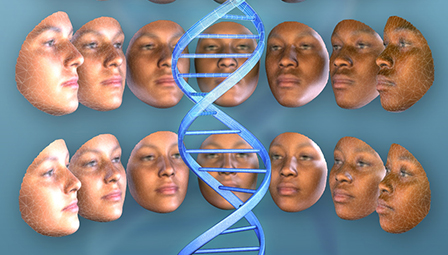
They found that the shapes of the end of the nose, the area above and below the lips, cheekbones and the inner corner of the eye were highly influenced by genetics. The team took scans of twins' faces using 3D cameras and custom built statistical software to generate thousands of points that were perfectly aligned across the faces and then measured how 'curved' each face looked at each one of those locations. The researchers then compared how similar these measurements were between identical twins, who have the same genes, and non-identical twins, who only share half of the genes. By seeing which parts of the face are the most similar in shape in a pair of identical twins, the researchers then calculated the likelihood that the shape of that part of the face is determined by genetics.
The features you're most likely to inherit from your parents Daily Mail - April 19, 2017
Subliminal effect of facial color on fearful faces PhysOrg - October 22, 2015
Facial color is suggestive of emotional states, as in the phrases: "flushed with anger" and "pale with fear." Although some behavioral studies have investigated the effects of facial color on expression, there is limited neurophysiological evidence showing the effects of facial color on emotional expression perception. Now, researchers found facial color affects early stage of subliminal processing of facial expression using ERPs, which provided the first neurophysiological evidence showing the effects of facial color on emotional expression perception. The researchers measured the brain activity from 15 participants during a facial emotion identification task of (1) neutral expressions of natural facial color, (2) fearful expressions of natural facial color, (3) neutral expressions of bluish facial color, and (4) fearful expressions of bluish facial color both in supraliminal and subliminal conditions. Bluish-colored faces increased the N170 latency effect of facial expressions compared to the natural-colored faces, indicating that the bluish color modulated the processing of fearful expressions in the subliminal condition
Human faces are so variable because we evolved to look unique Science Daily - September 16, 2014
Why are human faces so variable compared to other animals, from lizards and penguins to dogs and monkeys? Scientists analyzed human faces and the genes that code for facial features and found a high variability that could only be explained by selection for variable faces, probably because of the importance of social interactions in human relationships and the need for humans to be recognizable.
These Facial Features Matter Most to First Impressions Live Science - July 28, 2014
You may think you can judge a person you just met based on his or her facial expressions. Does a smile indicate a person is easygoing or insincere? Does squinting show concentration, or mistrust? First impressions of people - such as whether they are trustworthy, dominant or attractive - can develop from a glimpse as brief as 100 milliseconds or less. Brain scans suggests that such judgments are made automatically, probably outside of people's conscious control. But now, a computer system that mimics the human brain has identified which facial features most influence how others first perceive a person, scientists say.These findings could lead to computer programs that automatically see which photographs would help people give the best first impressions they can, the researchers added.
Happily Surprised! People Use More Facial Expressions Than Thought Live Science - March 31, 2014
When you're feeling one of those combination emotions, like sadly angry or happily disgusted, it shows on your face in a unique way, a new study shows. In fact, there may be at least three times more recognizable human facial expressions than previously thought, the researchers said. In a new study, researchers defined 21 facial expressions that we use to convey our emotions, and found that a computer model could tell them apart with a high degree of accuracy by looking for small changes in facial muscles. Among these facial expressions were the six, long-recognized basic emotions - happy, sad, fearful, angry, surprised and disgusted - but also 15 others, which were a combination of these basic feelings. For example, a person may show that they feel happily surprised, or angrily surprised, said the researchers, calling such feelings compound emotions.
3-D model links facial features and DNA Science Daily - March 24, 2014
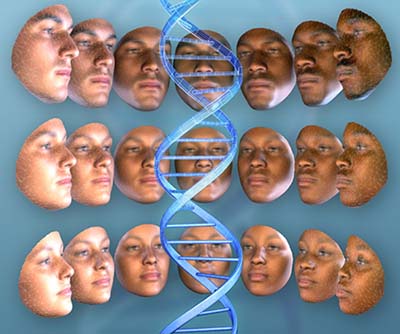
DNA can already tell us the sex and ancestry of unknown individuals, but now an international team of researchers is beginning to connect genetics with facial features, degrees of femininity and racial admixture. The researchers looked at both actual physical face shape and genetic markers of face shape.
Written all over your face: Humans express four basic emotions rather than six Science Daily - February 3, 2014
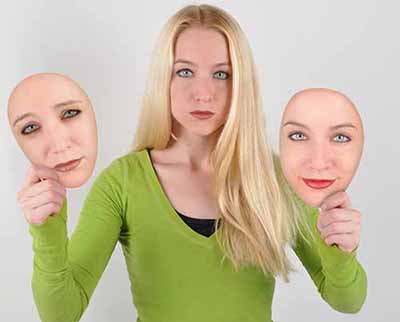
Human beings are emotional creatures whose state of mind can usually be observed through their facial expressions. A commonly-held belief posits there are six basic emotions which are universally recognized and easily interpreted through specific facial expressions, regardless of language or culture. These are: happiness, sadness, fear, anger, surprise and disgust. New research suggests that in fact, there are really only four.
Written all over your face: Humans express four basic emotions rather than six PhysOrg - February 3, 2014
Human beings are emotional creatures whose state of mind can usually be observed through their facial expressions. A commonly-held belief, first proposed by Dr Paul Ekman, posits there are six basic emotions which are universally recognized and easily interpreted through specific facial expressions, regardless of language or culture. These are: happiness, sadness, fear, anger, surprise and disgust.
Facial Expressions Show Language Barriers, Too Science Daily - August 16, 2009
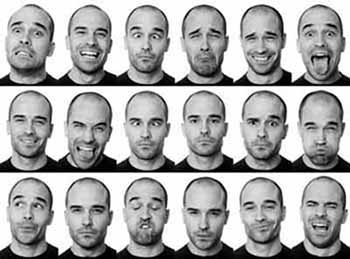
People from East Asia tend to have a tougher time than those from European countries telling the difference between a face that looks fearful versus surprised, disgusted versus angry, and now a new report published online on August 13th in Current Biology, a Cell Press publication, explains why. Rather than scanning evenly across a face as Westerners do, Easterners fixate their attention on the eyes.

A facial recognition system is a computer application for automatically identifying or verifying a person from a digital image or a video frame from a video source. One of the ways to do this is by comparing selected facial features from the image and a facial database. It is typically used in security systems and can be compared to other biometrics such as fingerprint or eye iris recognition systems.
Some facial recognition algorithms identify facial features by extracting landmarks, or features, from an image of the subject's face. For example, an algorithm may analyze the relative position, size, and/or shape of the eyes, nose, cheekbones, and jaw. These features are then used to search for other images with matching features.
Other algorithms normalize a gallery of face images and then compress the face data, only saving the data in the image that is useful for face recognition. A probe image is then compared with the face data. One of the earliest successful systems[4] is based on template matching techniques applied to a set of salient facial features, providing a sort of compressed face representation.
Recognition algorithms can be divided into two main approaches, geometric, which looks at distinguishing features, or photometric, which is a statistical approach that distills an image into values and compares the values with templates to eliminate variances.
Popular recognition algorithms include Principal Component Analysis using eigenfaces, Linear Discriminate Analysis, Elastic Bunch Graph Matching using the Fisherface algorithm, the Hidden Markov model, the Multilinear Subspace Learning using tensor representation, and the neuronal motivated dynamic link matching.
A newly emerging trend, claimed to achieve improved accuracies, is three-dimensional face recognition. This technique uses 3D sensors to capture information about the shape of a face. This information is then used to identify distinctive features on the surface of a face, such as the contour of the eye sockets, nose, and chin.
One advantage of 3D facial recognition is that it is not affected by changes in lighting like other techniques. It can also identify a face from a range of viewing angles, including a profile view. Three-dimensional data points from a face vastly improve the precision of facial recognition. 3D research is enhanced by the development of sophisticated sensors that do a better job of capturing 3D face imagery. The sensors work by projecting structured light onto the face. Up to a dozen or more of these image sensors can be placed on the same CMOS chip - each sensor captures a different part of the spectrum. Even a perfect 3D matching technique could be sensitive to expressions. For that goal a group at the Technion applied tools from metric geometry to treat expressions as isometries. A company called Vision Access created a firm solution for 3D facial recognition. The company was later acquired by the biometric access company Bioscrypt Inc. which developed a version known as 3D FastPass.
Another emerging trend uses the visual details of the skin, as captured in standard digital or scanned images. This technique, called skin texture analysis, turns the unique lines, patterns, and spots apparent in a personŐs skin into a mathematical space. Tests have shown that with the addition of skin texture analysis, performance in recognizing faces can increase 20 to 25 percent.

Facial Symmetry Matters - Golden Ratio Proportions
Text, Video, Images
It all begins with the eyes - consciousness and perception. Most people are drawn to look directly at the eyes first, unless there is a unique feature on the face that calls their attention. When two people meet, eye contact allows them, within a few seconds, to determine a connection or not. Eyes are the windows of the soul and reflect our inner self and issues.
Eye color is important, with light eye often more favorable then dark -- the lighter the better. Uniquely colored eyes, lighter shades of blue, seem to trigger higher frequency spiritual significance for some.
The person who looks away or has small squinty eyes is secretive and perhaps a dysfunctional personality, someone who does not want to relate. In contrast, a wandering or shifty eye portends a nature given to unsettled and inconsistent habits.
Direct eye contact reflects a personality, that can be controlling, strong, yet honest.
Unevenly set eyes convey that the person is capable of seeing things from a different perspective and applying lateral thought processes to resolving problems.
Ideally with a balanced personality the face has one eye width between each eye; it is even and thus balanced. Eyes closer set to the nose, imply a more limited view of the world. This person may prefer codependent relationships, often remaining at home and not leaving the family once reaching adulthood. This also goes to the person whose life path is parental caretaker. In this case, the person may feel cheated in life, have emotional problems involving moods swings. Professional help should be sought.
People with eyes set wider apart, may be more open minded about life and reality. They often fall into the holistic sciences as a means of self awareness, and find themselves in creative careers that reflect their inner issues. They need space, to be sure and can move on with the drop of a hat. Some have learning challenges, but that does not mean you should be the one to point out their faults, or they will leave. Not bad as friend, but not good in romantic relationships.

Deep set eyes go to deep, intense personality issues. and a serious mind These are the observers who like creative things and inspiring others with artistic expression. They are soul searchers, often here to make a difference with their endeavors. They are romantic and sometimes spontaneous. They are of sound judgement, compassionate and serious minded.


If you look at the eyelids of people through the millennia who were seers, great philosophers, creative geniuses, writers ... you will note they that many had heavy eyelids.
Cosmetic surgery on eyelids changes the look of the face as well.
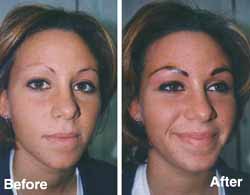
The shape of the eyebrows is easily altered with tweezing or waxing excess hair. One must note the end result to associate with personality type. Many people enhance their eyebrows with pencil or eye shadows. As people age, or if they are sick, the partial or full loss of one or both eyebrows is possible.
Eyebrows
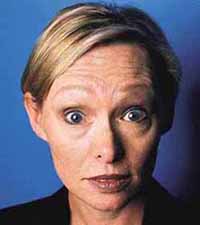
The forehead is the largest part of the face in most cases. Generally, male foreheads have a relatively flat slope from the hairline to the brow, where women's foreheads have a convex curve both vertically and horizontally. Male foreheads often have a heavy bony ridge just above the eyes, in a line beneath the eyebrows. This is called brow bossing. A brow lift is a soft tissue procedure which tightens skin on the forehead and raises the eyebrows. This is usually done with an incision at the hairline, or endoscopically from smaller incisions within the scalp hair. This has the effect of opening up the face and making you look less stern and tired. However, it has no effect on the underlying bone, so its effects are not as dramatic as bony work. A brow lift is often done at the same time as bony forehead work.
Forehead
Head Shape
Wrinkles
The appearance of wrinkle and lines on the face are usually genetic. They may also speak of a troubled life, too much time spent in the sun, and are sometimes called 'worry lines.' Once again, in this day and age, they can be concealed with botox, collagen, skin peels, makeup, and skin creams.
Wrinkles could be less than skin deep New Scientist - March 2005
It is not just our bodies that become stiff in old age. Skin cells also appear to become more rigid. The discovery might just lead to new ways to rejuvenate skin. Wrinkles and the leathery feel of old skin are thought to result from changes in the dermis, the deepest layer of skin. This becomes fibrous, making the skin less elastic.
The shape of the nose is genetic, unless broken or fixed. Much is stressed about the nose, causing many people to resort to rhinoplasty to create the most flattering look and sometimes for breathing purposes.
Chiseled features have always been in vogue. Most popular is a nose that has a high, straight, full and fleshy tip with gently flared but protected nostrils. The fleshy tip indicates cordiality and warmth of personality and an empathic nature. These people can set high standards for themselves and are generally polite.
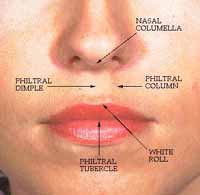
The groove on the upper lip below the nose is called the philtrum. If it is clearly marked, deep and long, it indicates strong and healthy energy levels and vitality. Flat, weak and unpronounced philtrums are sometimes indicative of reduced life force energy.
The mouth is related to communication, speech and the sensual appetites like eating and sex. The lips relate to our ability to nurture others in loving relationships. Many woman enlarge their lips as it makes them look more seductive.
Teeth: Many missing teeth generally indicate emotional problems
There are 9 types of chins:
Ears can also he altered with surgery, usually pinned back thus changing the shape of the face.
The ear is spiraled shaped like the nautilus which in metaphysics takes us to sacred geometry and the movement of consciousness - golden ratio.
Ears should exhibit good, fleshy inner and outer helixes. Thin and poorly shaped outer helixes may reveal diminishing health.

Hair and can add or subtract from the way we view facial features. To look young, keep your hair a youthful color and style. Style, texture, color, and length reflect personality, sexuality, from personality disorders. People who color their hair black, often suffer from depression, the outer expression mirroring the inner self. Astrological signs often link with hair; i.e. someone with a Leo Sun, will generally have a thick mane of hair.